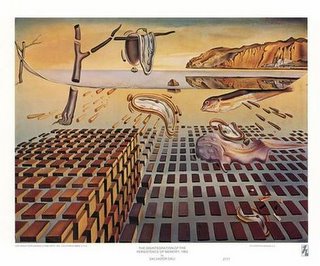Zombie Twin Philosophy
No qualia here...come back with more Brains.
It is for those who come and those who have yet to, and it is for me, so that I may understand what they come for...
In the Disintegration of the Persistence of Memory from 1954, Dali disintegrate d the scene from his popular 1931 painting The Persistence of Memory, located in New York's Museum of Modern Art. This disintegration is an acknowledgment of the developments of modern science. The disquieting landscape of his earlier work has here been shattered by the effects of the atomic bomb. All of the elements in the painting are separating from each other. The rectangular blocks in the foreground and the rhinoceros horns floating through space metaphorically suggest that the world is formed of atomic particles that are constantly in motion.
d the scene from his popular 1931 painting The Persistence of Memory, located in New York's Museum of Modern Art. This disintegration is an acknowledgment of the developments of modern science. The disquieting landscape of his earlier work has here been shattered by the effects of the atomic bomb. All of the elements in the painting are separating from each other. The rectangular blocks in the foreground and the rhinoceros horns floating through space metaphorically suggest that the world is formed of atomic particles that are constantly in motion.
Forms disintegrating as a result of the bomb populate the barren landscape. The soft skin of the face to the right is fluid, and the soft watch from the 1931 canvas is not just draped over a branch in the dead olive tree, it is ripping apart. By locating this work in the barren region of the Bay of Cullero, Dali revealed that the atomic bomb has disturbed even the serenity of the artist's isolated Port Lligat. Yet in spite of this painting's bleak implications, Dali presents the atomic disintegration in a harmonious pattern, indicating the persistence of an underlying order in nature.

"Artists of the Floating World" this expressive phrase can be found in Memoirs of a Geisha. According to the novel it refers to the role of Geisha in Japan and it hints at the seeming "ungroundedness" of the world of beauty and entertainment. It is particularly evocative as it simply and effectively describes the unconnected nature of such a world with the deeper "reality" that lies beneath. Or so one might intimate as an English speaker. It is related to the artistic style in Japan known as Ukiyo-e or "Pictures of the Floating World." These pictures are of landscapes, pastoral scenes, kabuki theater, and pleasure quarters. Hokusai and Hiroshige are perhaps the two most famous practitioners of this style of woodblock prints and painting. The picture here is one of Mt. Fuji by Hiroshige, one of his 53 Stations of the Tokaido Series. Hokusai is also extremely well known for his 36 Views of Mt. Fuji. Though, he is most famous for the often appropriated The Great Wave at Kanagawa. This understanding of the "Floating World" is a unique and genuinely frustrating concept to parse out. Are we in the Floating World? Does this apply to people, places and things...or is it a manifold of sensible perception, or a state of being? Moreover, does the Japanese understanding of the word "float," have any connection to ours. Should we be appropriating this term in novels about Geisha, of which we perhaps do not understand the role they played within Japanese society? Something suggests that perhaps, "The Floating World" is no less real, or important and is no "lighter" than other worlds or realities.